Sarah Sundin's Blog, page 419
August 8, 2013
Book Beat - Snow on the Tulips by Liz Tolsma
 What if saving the life of a stranger could cost you your own life?
What if saving the life of a stranger could cost you your own life?Snow on the Tulips by Liz Tolsma takes place in Nazi-occupied Holland in World War II. Dutch resistance fighter Gerrit Laninga is caught by the Germans and taken to the canal to be executed. But he survives and drags himself to a nearby house. Young widow Cornelia de Vries doesn't know what to do with the wounded stranger on her stoop. To protect him would endanger her life - and that of her little brother Johan who lives in hiding so the Nazis don't haul him into forced labor. Cornelia has no choice - she must help this man. As she nurses him back to health, they develop feelings for each other, but he also prods her conscience. Should she continue living as if invisible, to keep safe - or should she fight against evil.
With a tender romance, a gripping plot, and a well-researched setting, Snow on the Tulips drew me in to the harrowing uncertainty of life in the Netherlands under Nazi rule. Liz Tolsma’s beautiful story kept me up at night—not just wondering what would happen to her endearing characters, but wondering what I would do in similar circumstances. Do not miss this book!
If you'd like to learn more about Liz and her writing, stop by the Christian Authors Network blog today, where I'm interviewing Liz!
Published on August 08, 2013 02:00
Today in World War II History
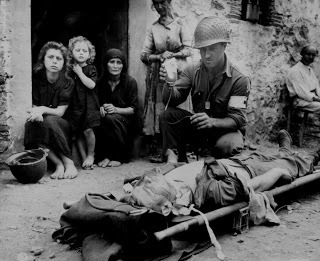 US Army PFC Harvey White administering plasma
US Army PFC Harvey White administering plasma to wounded Private Roy Humphrey, Sant' Agata, Sicily
Italy, 9 Aug 1943 (US National Archives) 70 Years Ago—Aug. 8, 1943: Lt. John F. Kennedy and PT-109 crew rescued from island in the Solomons by Navy patrol boat. US Seventh Army lands at Sant’ Agata on Sicily’s north coast to outflank Axis, takes San Fratello Ridge and Sant’ Agata, but fails to cut off German retreat.
Published on August 08, 2013 01:00
August 7, 2013
Today in World War II History
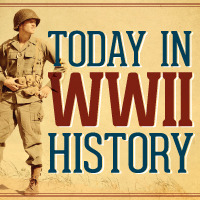 70 Years Ago—Aug. 7, 1943: Soviets launch offensive near Smolensk. Fighting erupts between nationalists and communists in Shantung Province, China.
70 Years Ago—Aug. 7, 1943: Soviets launch offensive near Smolensk. Fighting erupts between nationalists and communists in Shantung Province, China.
Published on August 07, 2013 01:00
August 6, 2013
Today in World War II History
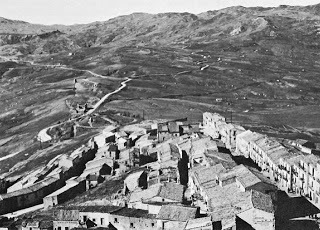 Troina, Sicily (US National Archives)70 Years Ago—Aug. 6, 1943: Battle of Vella Gulf: US Navy sinks 3 Japanese destroyers in Solomons, ending Japanese plans to reinforce New Georgia. US Seventh Army takes Troina, Sicily after heavy fighting—most Germans evacuated night before. Gen. Terry Allen of and his deputy Brig. Gen. Theodore Roosevelt Jr. (Pres. Teddy Roosevelt’s son) removed from command of US 1st Infantry Division.
Troina, Sicily (US National Archives)70 Years Ago—Aug. 6, 1943: Battle of Vella Gulf: US Navy sinks 3 Japanese destroyers in Solomons, ending Japanese plans to reinforce New Georgia. US Seventh Army takes Troina, Sicily after heavy fighting—most Germans evacuated night before. Gen. Terry Allen of and his deputy Brig. Gen. Theodore Roosevelt Jr. (Pres. Teddy Roosevelt’s son) removed from command of US 1st Infantry Division.
Published on August 06, 2013 01:00
August 5, 2013
Medical Air Evacuation in World War II - The Flight Nurse
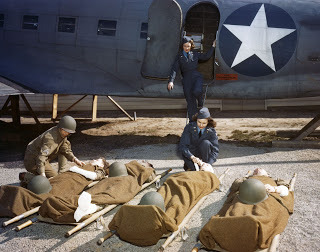 At the Army Air Force School of Air Evacuation at Bowman Field, Ky.,
At the Army Air Force School of Air Evacuation at Bowman Field, Ky., student flight nurses learned how to handle patients with the aid of a
mock-up fuselage of a Douglas C-47 transport. (U.S. Air Force photo)Flight nurse Lt. Georgie Taylor wrestled down Captain McCurdy’s arms while Sgt. Enrique Ramirez forced him back into the seat. Apparently the captain was a poor candidate for air evacuation.
“What are you waiting for, men?” McCurdy called out. “Jump!”Sergeant Ramirez planted his knee on the man’s lap and gripped both of the captain’s wrists in his big hands, locking him in place. “I got him.”“I’ll get the med.” Georgie dashed down the aisle, past all the patients craning their heads to get a good look. She flung open the lid of the medication chest. A roll of gauze bandages to use for restraints, scissors, a bottle of phenobarbital. (On Distant Shores, p. 249)In my novel On Distant Shores, the heroine serves as a flight nurse. To celebrate the book’s release, I’m running a series on medical air evacuation in World War II.
Earlier I discussed general principles of air evacuation and we followed one patient’sflight experience, and today we’ll meet the flight nurse.
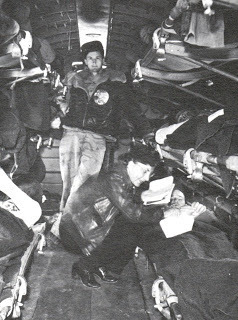 Lt. Aleda Lutz of 802nd Medical Air Evacuation Transport
Lt. Aleda Lutz of 802nd Medical Air Evacuation Transport Squadron in C-47 in North Africa. Lt. Lutz would be killed
in a plane crash in France Nov. 1, 1944,
one of 16 flight nurses killed in serviceTraining
The profession of flight nursing began in World War II. The US Army Air Force started the first training program at Bowman Field in Louisville, Kentucky in the fall of 1942. Training was haphazard at this point, and the first two squadrons (the 801st and 802nd) were sent overseas before training was complete. The formal program ran six to nine weeks, changing throughout the war. The first class of flight nurses graduated in February 1943.
The program was named the School of Air Evacuation in June 1943 and moved from Bowman Field to Randolph Field, Texas in October 1944. The US Navy started a flight nursing program in December 1944 in Alameda, California.
In training, the nurses studied academic subjects such as aeromedical physiology. They also learned field survival, map-reading, camouflage, ditching and crash procedures, and the use of the parachute. The program included calisthenics, physical conditioning, and a bivouac in the field with simulated enemy attack.
Organization
Each Medical Air Evacuation Transport Squadron (MAETS) was headed by a flight surgeon and chief nurse. The MAETS was divided into four flights, each led by a flight surgeon and composed of six teams of flight nurses and surgical technicians. A Headquarters section included clerks, cooks, and drivers. On July 19, 1944 the squadrons were re-designated Medical Air Evacuation Squadrons (MAES).
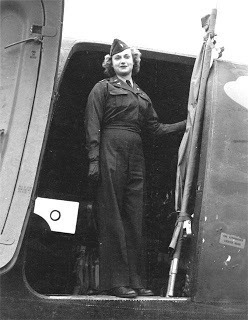 USAAF flight nurse uniformUniform
USAAF flight nurse uniformUniformThe typical Army Nurse Corps uniform of white dress or a skirted suit uniform did not work in flight. Although some resisted—including in ANC leadership—the women were allowed to wear trousers. The first few squadrons improvised uniforms, often cutting down the dark blue ANC service jacket and purchasing trousers. Eventually an official flight nurse uniform was authorized—a waist-length gray-blue jacket and matching trousers and skirt, with a light blue or white blouse. In 1944, the uniform was changed to olive drab, with a khaki blouse. Depending on the climate, nurses also wore the combat airman’s heavy flight gear.
The official insignia of the flight nurse was a pair of golden wings with a maroon N superimposed. These wings were changed to silver later in the war.
Duties
The role of the flight nurse was revolutionary. No physician accompanied her on the flight, and she outranked the male surgical technician, who worked under her authority. She was trained to start IVs and oxygen, tasks reserved for physicians at the time. In addition, she was trained to deal with medical emergencies including shock, hemorrhage, and sedation. One flight nurse even performed an emergency tracheotomy using improvised equipment.
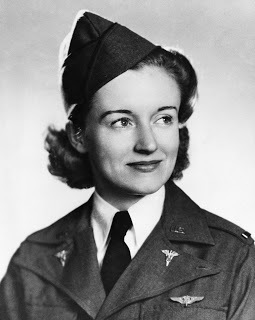 Lt. Ruth Gardiner, 805th MAETSDangers
Lt. Ruth Gardiner, 805th MAETSDangersThe primary responsibility for the lives of the patients rested on the shoulders of the flight nurses. Their emergency training was put into use in many cases throughout the war. Flight nurses and technicians successfully evacuated patients into life rafts after a ditching in the Pacific, unloaded patients from a burning plane after crash landing in North Africa, and loaded patients under enemy fire in the jungles of Burma.
One flight nurse was taken prisoner briefly by the Germans after crashing behind enemy lines, and another parachuted to safety in the mountains of China. In one dramatic incident, a plane carrying a dozen nurses from Sicily to Italy was blown off course and crash landed in Nazi-occupied Albania. With the help of Albanian partisans and Allied operatives, the crew and nurses all evaded capture and crossed snowy mountains to be rescued at the coast—a two-month ordeal. Cate Lineberry's recent book, The Secret Rescue (New York: Little, Brown and Company, 2013) gives an excellent account of the Albanian incident.
Sixteen flight nurses lost their lives during the war. Lt. Ruth Gardiner, 805thMAETS (pictured), was the first flight nurse killed, in a plane crash in Alaska.
Through professionalism and courage, the women who served as flight nurses in World War II saved many hundreds of lives and comforted over a million sick and wounded servicemen.
Resources:
Sarnecky, Mary T. A History of the U.S. Army Nurse Corps. University of Pennsylvania Press, Philadelphia. 1999.
Links, Mae Mills & Coleman, Hubert A. Medical Support of the Army Air Forces in World War II. Office of the Surgeon General, USAF. Washington, DC. 1955.
“Winged Angels: USAAF Flight Nurses in World War II.” On National Museum of the US Air Force website. http://www.nationalmuseum.af.mil/factsheets/factsheet.asp?id=15457
The World War II Flight Nurses Association. The Story of Air Evacuation: 1942-1989. Taylor Publishing Co., Dallas TX, 1989.
Website of the World War II Flight Nurse Association. http://www.legendsofflightnurses.org/ Contains photos, news clippings, and PDF of The Story of Air Evacuation.
Published on August 05, 2013 02:00
Today in World War II History
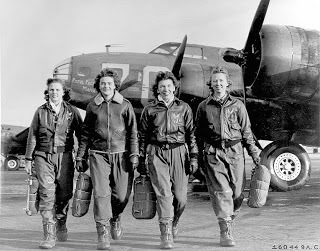 Frances Green, Margaret (Peg) Kirchner, Ann Waldner and Blanche Osborn
Frances Green, Margaret (Peg) Kirchner, Ann Waldner and Blanche Osbornleaving their B-17, "Pistol Packin' Mama," at the four-engine school
at Lockbourne AAF, Ohio, during WASP ferry training. (USAF photo)70 Years Ago—Aug. 5, 1943: US Army secures Munda Field on New Georgia, to become major airfield in South Pacific, putting all the Solomons in reach of fighters. WASP formed (Women’s Airforce Service Pilots) by combining Women’s Auxiliary Ferrying Squadron and Women’s Flying Training Detachment, under Miss Jacqueline Cochran, a civilian organization.
Published on August 05, 2013 01:00
August 4, 2013
Today in World War II History
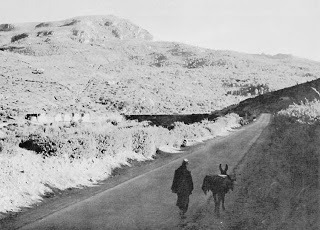 San Fratello Ridge, Sicily (US National Archives)70 Years Ago—Aug. 4, 1943: US Seventh Army launches attack on San Fratello Ridge on Sicily’s north shore.
San Fratello Ridge, Sicily (US National Archives)70 Years Ago—Aug. 4, 1943: US Seventh Army launches attack on San Fratello Ridge on Sicily’s north shore.
Published on August 04, 2013 01:00
August 3, 2013
Today in World War II History
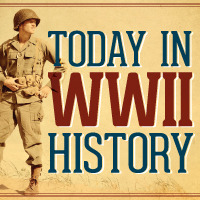 70 Years Ago—Aug. 3, 1943: German paratroopers arrive outside Rome to “protect” against Allied invasion, but really to occupy the city in case Italy surrenders. Gen. George Patton slaps a patient at the 15th Evacuation Hospital at Nicosia, Sicily for supposed cowardice—the patient suffered from malaria and combat fatigue (first of two such incidents).
70 Years Ago—Aug. 3, 1943: German paratroopers arrive outside Rome to “protect” against Allied invasion, but really to occupy the city in case Italy surrenders. Gen. George Patton slaps a patient at the 15th Evacuation Hospital at Nicosia, Sicily for supposed cowardice—the patient suffered from malaria and combat fatigue (first of two such incidents).
Published on August 03, 2013 01:00
August 2, 2013
Today in World War II History
 The crew of PT-109, Lt. John F. Kennedy at right70 Years Ago—Aug. 2, 1943: PT-109, commanded by future president Lt. John F. Kennedy, sunk off Solomons by Japanese destroyer Amagiri; the survivors swim 4 hrs to a deserted island. At Treblinka concentration camp, 200 Jews lead an armed revolt and burn buildings, but most are killed.
The crew of PT-109, Lt. John F. Kennedy at right70 Years Ago—Aug. 2, 1943: PT-109, commanded by future president Lt. John F. Kennedy, sunk off Solomons by Japanese destroyer Amagiri; the survivors swim 4 hrs to a deserted island. At Treblinka concentration camp, 200 Jews lead an armed revolt and burn buildings, but most are killed.
Published on August 02, 2013 01:00
August 1, 2013
Book Beat - Mistaken, by Karen Barnett
 This is a blog post I've been waiting to write for several years. I met Karen Barnett on this blog four years ago - she was one of my first followers. We became online friends, then met in person at the Mount Hermon Christian Writers Conference. I've watched her work hard as a writer - really hard. So I was delighted when she signed with my agent, Rachel Kent at Books & Such Literary Agency, and then signed a contract with Abingdon Books. Now I've had the joy of reading her debut novel,
Mistaken
. And it's a winner!
This is a blog post I've been waiting to write for several years. I met Karen Barnett on this blog four years ago - she was one of my first followers. We became online friends, then met in person at the Mount Hermon Christian Writers Conference. I've watched her work hard as a writer - really hard. So I was delighted when she signed with my agent, Rachel Kent at Books & Such Literary Agency, and then signed a contract with Abingdon Books. Now I've had the joy of reading her debut novel,
Mistaken
. And it's a winner! Karen Barnett and I at the Mount Hermon Christian Writers Conference, 2013In 1926, the Twenties are roaring in the coastal border town of Port Angeles, Washington. Switchboard operator Laurie Burke is fed up with her alcoholic father and rumrunning brother, yet fiercely protective of them, and she longs for one good man in her life, a man she can trust. Then she meets handsome pharmacist Daniel Shepherd, who fills her father's prescriptions for medicinal alcohol and seems connected to her brother's gang - and has a secret of his own. Federal agent Samuel Brown seems a more likely man to trust...but she can't shake her connection to the mild-mannered pharmacist.
Karen Barnett and I at the Mount Hermon Christian Writers Conference, 2013In 1926, the Twenties are roaring in the coastal border town of Port Angeles, Washington. Switchboard operator Laurie Burke is fed up with her alcoholic father and rumrunning brother, yet fiercely protective of them, and she longs for one good man in her life, a man she can trust. Then she meets handsome pharmacist Daniel Shepherd, who fills her father's prescriptions for medicinal alcohol and seems connected to her brother's gang - and has a secret of his own. Federal agent Samuel Brown seems a more likely man to trust...but she can't shake her connection to the mild-mannered pharmacist. As a pharmacist myself, married to a pharmacist, of course I have an inherent interest in this story! Karen's research into pharmacy practice in the 1920s is phenomenal.
As a pharmacist myself, married to a pharmacist, of course I have an inherent interest in this story! Karen's research into pharmacy practice in the 1920s is phenomenal. Mistaken is a thrilling read, full of mystery and danger and romance. The characters have depth and strength and just the right amount of flaws. Best of all, the story makes you think. It makes you think about first impressions and secrets and jumping to conclusions. It makes you think about whether it's best to protect a loved one - or to let them fall. It makes you think about temptation and forgiveness and the consequences of past sins. Do not miss this novel! I can't wait for Karen's upcoming three-book series centered around the 1906 San Francisco Earthquake.
Published on August 01, 2013 07:11



